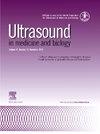经颅超声超分辨率成像中血脑屏障破坏的可能性。
IF 2.4
3区 医学
Q2 ACOUSTICS
引用次数: 0
摘要
超分辨率(SR)超声成像极大地提高了微血管图像的衍射极限分辨率。超声与造影剂,如在SR中使用的造影剂,在一定条件下可以打开血脑屏障(BBB),这是公认的。本研究旨在量化三维经颅超声SR中潜在血脑屏障破坏(BBBD)作为机械指数(MI)和压力分布的函数。小鼠采用常规3d SR序列成像。通过染料外渗荧光成像定量测定BBBD的力学指标,范围为0-0.78(水中测量)。结果表明,在0.78 MI处获取三维SR图像时,发生BBBD;然而,在0.78以下没有明显的染料外渗,成像是可以实现的。此外,还进行了水听器测量和三维模拟,以估计大脑中的局部压力分布。对于换能器表面MI为0.64,脑内局部MI估计平均为0.18±0.09,范围从0.03到0.44,未观察到明显的BBBD。然而,当换能器表面MI值为0.78时,观察到显著的BBBD (p < 0.05),其中脑内MI值范围为0.04 ~ 0.53,平均为0.22±0.11。这表明产生BBB生物效应的局部脑梗死在0.44-0.53 MI范围内。对于0.78 MI的病例,根据水听器测量,4.8%的脑总容积的压力高于0.44 MI(扫描的100 mm2二维平面为4.8 mm2),根据模拟,11.10% (777.5 mm3体积中的74.6 mm3)。本文章由计算机程序翻译,如有差异,请以英文原文为准。
The Potential for Blood–Brain Barrier Disruption During Transcranial Ultrasound Super-Resolution Imaging
Super-resolution (SR) ultrasound imaging dramatically improves the resolution of microvascular images beyond the diffraction limit. It is well-established that ultrasound with contrast agents, such as those used in SR, can open the blood–brain barrier (BBB) under certain conditions. This study aimed to quantify potential BBB disruption (BBBD) during 3-D transcranial ultrasound SR as a function of mechanical index (MI) and pressure distribution. Mice were imaged using conventional 3-D SR sequences. BBBD was quantified through fluorescence imaging of dye extravasation for mechanical indices in the range of 0–0.78 (measured in water). The results suggest that when 3-D SR images are acquired at 0.78 MI, BBBD occurs; however, imaging was achievable without significant dye extravasation below 0.78. In addition, hydrophone measurements and 3-D simulations were performed to estimate local pressure distributions in the brain. For a transducer surface MI of 0.64, estimates of the local MI within the brain averaged 0.18 ± 0.09, ranging from 0.03 to 0.44, with no significant BBBD observed. However, for a transducer surface MI of 0.78, significant BBBD was observed (p < 0.05), where the values in the brain range from 0.04 to 0.53, averaging 0.22 ± 0.11. This suggests that the local MI that generates BBB bio-effects is within the range of 0.44–0.53 MI. For the 0.78 MI case, 4.8% of the total brain volume had a pressure above 0.44 MI according to hydrophone measurements (4.8 mm2 of the 100 mm2 2-D plane scanned) and 11.10% according to simulations (74.6 mm3 of the 777.5 mm3 volume).
求助全文
通过发布文献求助,成功后即可免费获取论文全文。
去求助
来源期刊
CiteScore
6.20
自引率
6.90%
发文量
325
审稿时长
70 days
期刊介绍:
Ultrasound in Medicine and Biology is the official journal of the World Federation for Ultrasound in Medicine and Biology. The journal publishes original contributions that demonstrate a novel application of an existing ultrasound technology in clinical diagnostic, interventional and therapeutic applications, new and improved clinical techniques, the physics, engineering and technology of ultrasound in medicine and biology, and the interactions between ultrasound and biological systems, including bioeffects. Papers that simply utilize standard diagnostic ultrasound as a measuring tool will be considered out of scope. Extended critical reviews of subjects of contemporary interest in the field are also published, in addition to occasional editorial articles, clinical and technical notes, book reviews, letters to the editor and a calendar of forthcoming meetings. It is the aim of the journal fully to meet the information and publication requirements of the clinicians, scientists, engineers and other professionals who constitute the biomedical ultrasonic community.

 求助内容:
求助内容: 应助结果提醒方式:
应助结果提醒方式:


